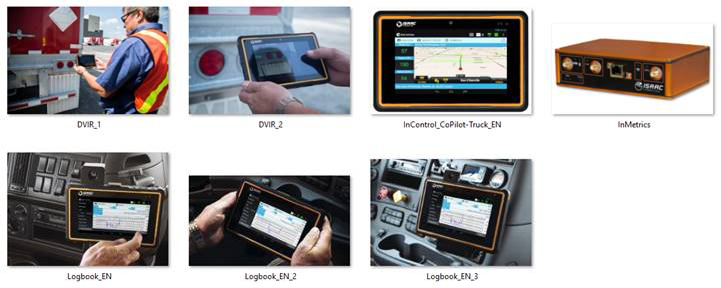
Click HERE to see the Isaac Instruments ad in the Fall 2018 issue.
July 20, 2017 – News Release
Using Big Data to Build Reliable Business Intelligence
Over the past few years, technology has evolved when it comes to connected devices and the endless possibilities surrounding the Internet of Things (IoT). But what does it mean for the trucking industry? Can big data have a significant impact on a fleet’s operations? Absolutely, but a system must be able to transform raw data into actionable information and integrate it with the company’s different information systems.
From Raw Data to Gaining Insight
A significant amount of data can be collected from trucks in operation. Engine torque, RPM, vehicle speed, transmission gear, and cruise control usage to name a few, are parameters a telemetry recorder can monitor. Big data can be complex, ambiguous and overwhelming. In itself, it has no practical use.
“The true power of telemetry emerges when data is analyzed and transformed into actionable information,” said Jacques DeLarochellière, president of ISAAC Instruments, a company whose expertise lies in telemetry and telematics. For instance, the load a driver is assigned influences fuel consumption. The heavier the load, the higher the consumption, given that all other factors are identical. Therefore, measuring driver performance based solely on fuel efficiency is inappropriate.
So how can the driver’s performance be correctly measured? Factors such as traffic, truck model, route type and load, have a direct impact on fuel efficiency, but are out of a driver’s control and should not be considered for measuring performance.
Focus must be given to actions drivers perform behind the wheel. Braking, accelerating and changing gears, for example, have an immediate effect on fuel efficiency. By using telemetry data, it is possible to improve on how and when these actions are performed. “Our system coaches drivers in real time so they can perform appropriate acceleration, anticipation and other maneuvers under their control that have a significant impact on fuel economy,” added DeLarochellière. 
A Step Further
To get the full benefit of big data, it must be fully integrated with the company’s different information systems. “Accessing this information is a challenge some suppliers have yet to overcome,” said DeLarochellière.
When a diagnostic trouble code (DTC) occurs while the truck is on the road, the fleet manager should automatically be notified so he can take prompt and appropriate action. Should the truck pull over to prevent a major breakdown or can the repair wait until it returns to the terminal? A quick look at the telemetry data provides this information and helps determine if another tractor is required to complete this trip, in order to remain on schedule and meet the client’s expectations.
For Claude Robert, Chairman of Groupe Robert’s Board of Directors, accessing this operational information plays a major role in the company’s success. “Employees don’t always have their eyes fixed on their computer screen. When pushing the information instantly to the right manager, the right decision is made quickly.”
Leading the Way
To be successful, transport companies need to use the data at their disposal to make informed decisions. Doing so not only lets them operate more efficiently, but also grants them a considerable competitive advantage.
There is no such thing as too much data, but efficient tools are essential to transform this data into business
intelligence.

Click HERE to see the Imperial Oil Limited ad in the Winter 2017 issue.
August 10, 2015 – Press Release
Successfully Optimizing Oil Drain Intervals Requires The Right Planning Procedures
Establishing an optimized oil drain interval is a lengthy process. It can be labor and time intensive. But the potential benefits can be exceptional.
In addition to helping to save money on maintenance costs, a successful, extended oil drain interval program can help trucks and commercial equipment run more miles or operate longer with each gallon of oil, which is good for a company’s bottom line and the environment.
As a senior field technical advisor for Imperial Oil, Stephanie Jaworski knows that when trying to extend oil drain intervals, having positive results are a direct result of having the right process in place.
“Our ultimate goal is to help identify the oil drain interval that will yield the lowest total operating cost without sacrificing engine reliability – or the resale value of trucks,” Jaworski said. “But it’s important to understand that each fleet’s needs, equipment, and maintenance protocols are different.”
That’s why Jaworski says she and her team seek to customize drain interval targets for each fleet they work with.
For example, Jaworski and her colleagues worked with the maintenance team at Danfreight Systems (DFS), a Quebec-based fleet that specializes in refrigerated transport and operates more than 130 tractor trailers, the majority of which are Peterbilt’s with PACCAR MX-13 engines.
Working together, Jaworski and her colleagues helped to determine a lubricant solution capable of helping the company reduce both operating costs and environmental impact.
“Our analysis of the fleet’s operations supported the recommendation that switching from a conventional, mineral-based engine oil to Mobil Delvac 1TM ESP 0W-40 synthetic diesel engine oil, would deliver significant benefits for the DFS fleet,” Jaworski said.
Since making the transition to a synthetic engine oil more than two years ago, the company has reported that it has successfully extended oil drain intervals to 100,000 km for the majority of its fleet, reducing fuel consumption and lowering maintenance costs.
Used oil analysis results have shown that even with the extended oil drain intervals, the engines have exhibited normal wear patterns, with some parts of the engines exhibiting no wear at all.
According to Jaworski, the Imperial Oil team uses a comprehensive, data driven approach that employs a wide range of tools and expertise to support fleets that want to extend oil drain intervals, including:
• State-of-the-art lubricant technologies, laboratories and facilities;
• Data-driven methodology and analytical tools;
• Specialized engineering services;
• Dedicated and experienced engineers; and,
• Close working relationships with leading OEMs.
Typically, Jaworski said, the work occurs across four distinct phases, which are central to Imperial Oil’s approach to optimizing oil drain intervals. They include:
Stage 1: Feasibility analysis— A thorough analysis of the fleet’s current duty cycle and maintenance practices helps determine different optimized oil drain interval scenarios that should be tested in order to quantify potential cost savings and sustainability-related benefits.
At this stage, the key items evaluated are:
• The type of application the fleet is used for;
• Climates and terrains in which the equipment is operating;
• The equipment type, age, and emission compliance;
• Experience of the maintenance staff; and,
• If available, the fleet’s used oil analysis history.
This is also a time to engage the fleet’s OEM partner/s. Doing so, right from the start, can play a critical role in helping understand any engine warranty and policy implications of the extended drain intervals.
Stage 2: Field test — A series of in-service testing programs, which may continue for a year or more, can help determine whether the fleet or company can operate efficiently between the proposed, targeted service intervals.
Stage 3: Evaluating results — A thorough data analysis will help ensure that the service interval recommendations are safely achievable.
Stage 4: Ongoing program maintenance — Periodic reviews and continued customer education will help ensure that business objectives are being achieved and program protocols are being followed.
Click here to learn how the team behind Mobil Delvac approaches the process of optimizing oil drain intervals.
Did You Know? Imperial Oil is an affiliate of ExxonMobil.


 1-866-985-9791
1-866-985-9791



